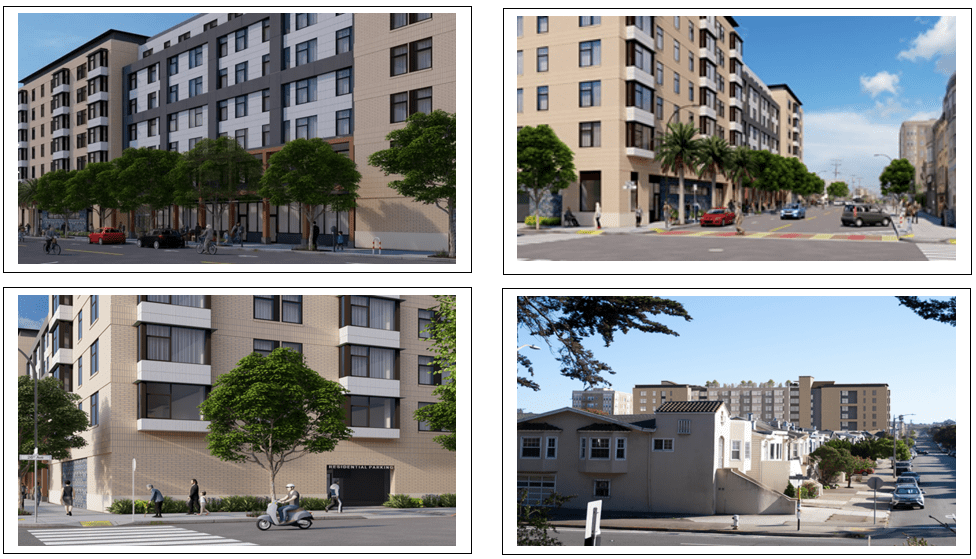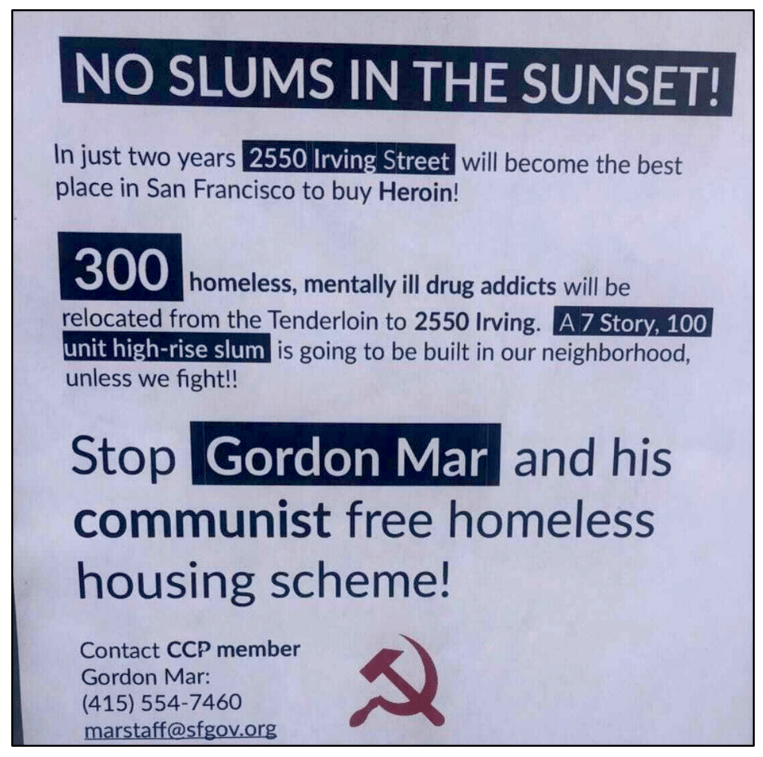In February 2021, San Francisco officials unveiled plans to build a 100% affordable housing project in the Sunset District of San Francisco. The Sunset District is located on the west side of San Francisco, an area that has seen little new construction of affordable housing developments over the past decade. The Sunset District is designated as “District 4” based on San Francisco Supervisorial District Maps. According to data from SFYIMBY, a non-profit focused on the development of housing units in San Francisco, District 4 has seen only 26 net new affordable units and 64 total new units from 2010 to 2020. In addition, in fiscal year 2019-2020, more than 5,000 applicants for affordable housing in San Francisco lived in District 4. However, only 49 applicants successfully found housing in that time period, all of whom were relocated outside the boundaries of District 4.
The vast majority of the western portion of the City is zoned for low-density single-family and duplex units, and historically building any high-density multifamily projects has been a challenge. The 100% affordable project, to be located at 2550 Irving Street, is proposed by Tenderloin Neighborhood Development Corporation (TNDC), a non-profit developer who focuses on 100% affordable housing developments in San Francisco. The project was partially financed through Inclusionary Housing Fees, a fund overseen by the San Francisco Mayor’s Office of Housing Community Development (MOHCD), which was created to oversee and implement inclusionary housing fee funds. Projects utilizing inclusionary housing fee funds, like 2550 Irving Street, are required to build 100% affordable housing projects. The 2550 Irving project has made headlines in San Francisco over the past few months, as the Mid-Sunset Neighborhood Association was created to combat the development in their community. The project, which utilized an SB-35 application, was not legally required to hold community meetings with the Mid-Sunset Neighborhood Association due to the by-right approval nature of the SB-35 application. However, according to statements by Katie Lamont, senior director of housing development at TNDC, although the project itself doesn’t have to come to a vote for approval, they want to engage the community on the design impact of the building. Ultimately, Mid-Sunset Neighborhood has filed a lawsuit alleging the 2550 Irving Street project represented a breach of contract, negligence, and breach of “implied covenant of good faith and fair dealing”. The lawsuit is unlikely to shut down the development due to the by-right nature of the SB-35 application; however, the community’s opposition to the project will cause many months of further delays.
This article gives a brief background on how 100% affordable housing projects like 2550 Irving Street are developed in San Francisco, as well as the balance developers must consider surrounding the time-consuming nature of community involvement as the dire need to increase affordable supply in San Francisco continues.
The Proposed Project
The proposed 2550 Irving Street development will offer a seven-story building design with 91 total units. Of the total, 73 units will be set aside for families earning between $38,450 to $102,500 per year, and 17 units will be set aside for formerly homeless families. In addition, the building will offer 2,250 square feet of ground-floor community space and a rear courtyard. Renderings of the proposed design are highlighted below:

What Are Inclusionary Housing Fees and How Does Senate Bill-35 Play A Role?
Inclusionary housing fees are one of three ways market rate developers in San Francisco are allowed to fulfill their inclusionary housing requirements. For instance, if a market rate developer is proposing a project of 25 residential units or more, and the developer does not want to include any affordable units in the development, they will pay an “inclusionary housing fee”. As of the date of this article, the fee is calculated as $199.50 per square foot of gross floor area applied to 30% of the project’s size. Based on data from the City and County of San Francisco Controller and Budget Analysis Division, fees collected from the program have been approximately $200,000,000 from 2014 to 2019 (the most recent data available). These funds raised are set aside exclusively for the development of 100% affordable housing projects. In most cases, the collected funds are then awarded to non-profit developers like TNDC to develop projects similar to 2550 Irving Street. From 2014 to 2019, 96 100% affordable projects have been completed, which translates to 6,112 total units. The fees generated and distributed to non-profit developers are overseen by the Mayor’s Office of Housing Development (MOHCD). Typically, MOHCD will identify a development site within the City and issue requests for qualifications; non-profit developers respond with their credentials and vision for the project. Once a developer is selected and construction starts, MOHCD issues funds for the project, which typically amount to 25% to 50% of the total project costs, based on the amount of other non-city funding sources.
Written into San Francisco’s charter is that every permit is discretionary, meaning all proposed developments need to receive conditional use permits, even if the proposed use is a legal zoning use. For 100% affordable housing projects in San Francisco, there has historically been much community involvement necessary in order for 100% affordable housing projects to be built. At times, community concerns are legitimate traffic, parking, and density issues; however, not-in-my-backyard (NIMBY) mindsets within San Francisco are also prevalent surrounding affordable housing projects. As a response to a long entitlement and community involvement process for affordable housing projects in San Francisco and California at large, State Senator Scott Wiener introduced Bill 35, which was enacted in 2017. The bill included many housing initiatives, including changing 100% affordable housing projects into by-right housing. By-right housing approval allows construction to begin for a development without acquiring discretionary approvals from the planning commission. According to Sam Moss, Executive Director at Mission Housing Development Corporation, the by-right nature of SB-35 projects has made the development process faster by months, if not years, for non-profit developers to build 100% affordable housing projects. The difficulty developers now face, including TNDC with their 2550 Irving Project, is how much community involvement is truly necessary now that the projects have become by-right. In the case of TNDC and the 2550 Irving Project, engaging with the community on their plans for the project has caused multiple delays, a reduction of 50 units in the overall size of the project, and a lawsuit against the developer from the Mid-Sunset Neighborhood Association.
The Community Opposition to 2550 Irving Project
After the 2550 Irving Street project was proposed, a neighborhood group was formed to raise their concerns surrounding the development. During a community meeting at a local church in the Sunset District, 200 opponents of the 2550 Irving Project gathered to discuss their concerns. The concerns from the community were expressed through signs held by community members with messages like “Be Kind To The Adjacent Community”, “Tell the Supervisor To Stop Toxic Waste”, and “The Right To Light For All Neighborhoods”, which were noted by a local San Francisco Chronicle reporter who was at the meeting in November 2021. In addition, multiple persons in the crowd targeted Gordan Mar, the District Four Supervisor for the Sunset District, with chants of “Recall Mar, Recall Mar”. Anonymous attack posters were posted throughout the Sunset neighborhood and slipped into mailboxes that read “No Slums In The Sunset” and “In just two years, 2550 Irving Street will become the best place in San Francisco to buy heroin” as well as additional attacks on the project, its tenants, and Gordon Mar himself. An image of the mentioned poster is highlighted below:

The intense opposition to the 2550 Irving Project highlights the challenges affordable housing developers face in San Francisco, especially in the western portions of the city which have seen extremely few affordable or multifamily housing developments.
The Balancing Act of Community Engagement
The intense community opposition to the 2550 Irving Street Project is clear; however, this opposition is not unique to 2500 Irving Street but rather consistent with the difficulties affordable housing developers face throughout the City on all affordable projects. According to local developers in the San Francisco area, many homeowners in San Francisco assume 100% affordable housing projects being built today will resemble some of the failed public housing projects that were previously developed in San Francisco and resembled large 15-story concrete blocks. However, as noted by Sam Moss, Executive Director at Mission Housing Development Corporation, newly developed 100% affordable housing projects being built in San Francisco today usually resemble well-designed market-rate housing. People are typically unable to differentiate between an affordable housing project and market-rate products. To combat the strong community opposition to affordable housing in the City, non-profit developers have historically engaged deeply with the community in order to receive their preliminary approvals.
One downside of the SB-35 is that it has not had time to normalize itself in the mindset of many non-profit developers in the City. For decades, affordable housing developers have tried to blend into the neighborhood and make the smallest amount of noise possible, in hopes their projects would get through the long approval process. In return, concessions on the number of units for many projects had to be made, ultimately reducing the much-needed supply of affordable housing units in San Francisco. The goal for 100% affordable developers, and people responsible for entitling these projects, is to become more accepting of the by-right power that SB-35 gave 100% affordable projects. History has shown that local communities within the City will continue to fight against 100% affordable developments, especially in neighborhoods in the western portions of San Francisco that see little multifamily development of any type. Thus, in order for the City to become a more affordable and equitable place, non-profit developers may need to change their mindset from minimizing their presence to using the power of SB-35 to create more affordable living options, with greater density and at an accelerated pace.
